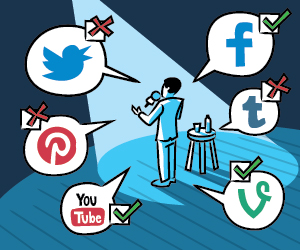 This post originally appeared in our May ’13 issue of “Live Report from the Future of Marketing,” our monthly Post-Advertising newsletter. Subscribe for free here.
This post originally appeared in our May ’13 issue of “Live Report from the Future of Marketing,” our monthly Post-Advertising newsletter. Subscribe for free here.
Why would I care? Why would I share? These are two key questions that Droga5’s chief creative officer, Ted Royer, says his agency considers when creating social content for brands on Facebook.
Royer and Carlos Figueiredo, associate creative director at Publicis Kaplan Thaler, hashed out what makes engaging Facebook content during a Creative Week panel titled “Newsfeeder: The Most Creative Posts From Facebook Brands,” moderated by BuzzFeed’s CCO, Jeff Greenspan. We’ve gathered a few of the key takeaways from the conversation for you as well as specific brand takeaways.
1. Don’t Be Dull
Brands want to be your friends, and like a good friend, a brand should have something new to offer every time it interacts with its audience. Essentially, a brand should be as interesting as its audience’s friends are and have a wealth of things to say.
If a brand is going to engage in social media, it can’t be boring. In other words, it shouldn’t be the guy who walks around at a party and repeats the same joke, praises himself and shares only stories about him. What works in a TV or print campaign (three ads transmitting the same message) usually does not work in social media.
Brand Tip:
Create a content calendar that has different types of content offerings every day. Try to diversify as much as possible (photos, memes, videos, links, questions/quizzes, games, etc.), and utilize user-generated content as well.
2. Create Multifaceted Brand Identities
Sometimes brand narratives are dictated by what is said in traditional media. But often those narratives that are created for TV or print are not true enough to the brand to play in the social space—they are one-dimensional and leave no room for real conversations or natural growth.
Agencies must help brands bridge the gap between traditional and digital advertising, going deeper into the brand story to create compelling social content. To go deeper, it is essential to understand the brand’s mission and identity. If you think about your brand as a character (or persona), developing a rich personality for it, you’ll better understand the types of content your brand should and should not be publishing as well as the topics it should and should not comment on.
Brands have to carefully determine which conversations are appropriate for them to join. As things happen in the world, think about how they relate to the brand. Even if a brand isn’t talking about the specific event, understand the environment and adjust content publishing accordingly (e.g., don’t tweet about your award as a natural disaster is happening).
Brand Tip:
Always ask, Does the social content I’m creating fit the role and tone of voice I’ve developed for my brand? Does it have the authority to publish?
3. Test and Learn
Instead of your investing millions of dollars in a new, traditional advertising campaign you’ve just dreamed up, social media offers a place to test and learn with smaller campaigns. If these ideas are well received on the appropriate social channel, the brand can start developing a full-blown social and/or traditional campaign. Vet things by your own audience. Figure out what you did right, and continue to play with and develop the idea.
Brand Tip:
There are established and emerging platforms that are free to join that provide innovative ways to offer content to audiences. Lowe’s did this wonderfully with Vine. If the test-and-learn campaign doesn’t work, it’s been exposed to only a small audience. But if it works, that content can be extended to the audience’s audiences and beyond. Don’t be afraid to try!
4. Unlock the Truth
Social content should be thought of in the same way a stand-up comic would think about a joke—as immediate and fairly disposable. People should laugh and move on. Regarding the Newcastle #nobollocks campaign that Droga5 created, Royer said the idea was to be too honest and reveal the machinery behind the bullshit through feisty, attention-grabbing images and refreshingly true statements, like “Newcastle winter IPA. Our worst selling beer in the summer. #NoBollocks.” One of the April Fool’s Day gags that Publicis Kaplan Thaler created for Scope, about bacon-flavored mouthwash, was shared almost three times more (112,803) than it was liked (30,971).
Not every brand can own humor, however, or should try to play in that space. Recognize the role of the brand, and create from a place that is relevant. Comedians and writers are trying to scrape away the inessential to reveal a truth, and truth is by far the most powerful thing a brand can bring to life. The best content reframes something already known, and the content that is shared the most is the content that helps promote one’s own identity and strengthen one’s social bonds.
Brand Tip:
Be careful about the tone your brand takes, and don’t reach for humor. Branded attempts at humor often can backfire or simply fall flat. Be true to the brand.
Speed, honesty, humor, usefulness and relevance are some of the most important aspects of creating dynamic social content.
Is your brand creating the dynamic content that audiences want, or is it just creating content that furthers the brand’s own agenda?


